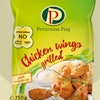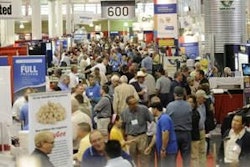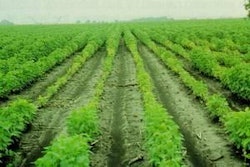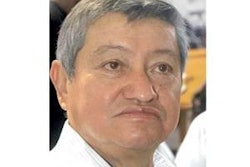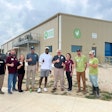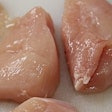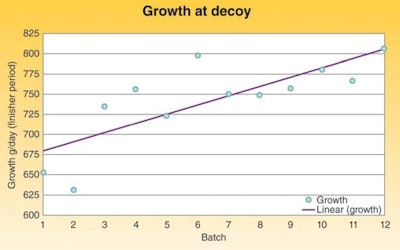
JSR Genetics Ltd., imported pig finishing equipment from the United States for its new state-of-the-art fully slatted and totally enclosed 8,100-place wean-to-finish UK facility, Decoy Farm at a cost of £2.1million.
Explaining the reason behind importing finishing equipment from North America, Glenn Dams managing director of JSR Farms said: “The UK has the best loose-housing systems for pigs, but it is lagging behind other countries with regard to pig finishing. As well as a pig breeding stock producer, JSR has a substantial commercial pig operation and this unit required top-quality buildings and equipment so the pigs can express their maximum genetic potential.”
Wean-to-finish facility
Local pig building company, A.M.Warkup Ltd., won the contract to build the new JSR facility at Decoy Farm. Skov provided the ventilation equipment and the finisher slats are Belgian. So is the six-wheeler Joskin slurry tanker.
As it happened, the Warkup team knew a local Yorkshire pig producer who had imported GroMaster sorter/weighers from the United States and has had excellent results with this technology. So, together with JSR they went across the Atlantic to see these systems in operation.
Impressed with what they saw, 12 GroMasters were purchased and fitted into the new Decoy Farm facility. The UK team was also purchased wet and dry ad lib feeders made by Manitoba-based Crystal Spring which they spotted while in North America. The actual feed conveying equipment was sourced from Belgium by Roxell with its MULTIfast feed management system, which can provide 497 different pig feed combinations.
“In fact, our biggest headache was getting the Roxell feed system to work properly; stockmanship is, of course, vitally important for good performance, it took an IT specialist to get everything working 100 percent, “said Dams.
Pig finishing technology
The first pigs were introduced into Decoy Farm in July 2010 and now 22 day-old pigs are moved to the facility every two weeks. The nursery has five rooms, each of which contain six pens that house 120 pigs in each (3,600 pigs in total). The pigs are split sexed in the nursery into entires and gilts, three pens of each. Initially they are fed a creep diet as gruel, but they soon are feeding on pellets.
From the nursery, the pigs go into the finisher section, which has six rooms, each containing two pens of 350 pigs each including the GroMaster units. After a two-week acclimatization period, training on the GroMasters starts on a Wednesday and by the following Monday the pigs have learned to work the equipment.
The pigs must enter the sorter to get to feeders. The three-way, sorting-end gate automatically allocates the pig by weight into either a light, medium or heavy pen, where they are fed a diet appropriate to their weight relative to the growth curve.
To a pig farmer who uses manual pig weighers and the hassle that goes with it, watching the huge numbers of pigs being weighed automatically and free from stress is just mind-boggling. Decoy Farm is designed with the minimum amount of labor required to run the pig unit. The entire pig farm is run by two technicians with remote monitoring from the JSR head office at Southburn.
Too often UK pig producers have to defend the poor standard of finishing facilities in England. While many pig farmers claim they can “eyeball” pig weights without the need for a sophisticated system, what they don’t reveal are the slaughter return sheets and the number of overweight pigs on them.
The target pig carcase weight is currently 81kg and the GroMaster system automatically records and marks the number of pigs reaching the required slaughter liveweight. Decoy Farm also has an overspill finisher room with 20 pens housing 15 pigs each, which takes lighter tail-end pigs.
Pig equipment ROI
This large pig farm uses a vast quantity of water, so JSR decided to drill a bore hole, rather than tap into the local water supply.
“The water quality is fine apart from an excess of magnesium and iron, which is removed before the water enters the system,” said Dams. “This is definitely a cheaper option than mains water and we reckon on a two-year payback. The whole system is pretty robust as the temperature dropped to -17 C last winter and nothing froze.”
The system’s software can produce reams of pig data. JSR uses meat per ton of feed, as a performance benchmark, because this metric is more meaningful than feed conversion ratios or daily liveweight gain growth rates. The accumulative batch data has revealed a steady improvement in feed conversion ratios, daily liveweight gains and meat per ton of feed, along with a decrease in pig mortality (see graph).
Canadian sow nucleus unit
When JSR traveled to North America for pig equipment, the company was also looking for any opportunity to boost its position in the global pig market to help meet the increased worldwide demand for pig breeding stock. In July 2009, JSR Genetics bought a 650-sow nucleus unit in Saskatchewan, Canada. The Elstow unit was purchased from the Prairie Swine Centre, which has a strong reputation for applied pig research in Canada and further afield.
“Any large pig breeding company needs to have an insurance policy as far as maintaining bloodlines,” said Dr Grant Walling, JSR Genetics managing director. “Canada in general is an ideal ‘storage facility’ for our stock and Elstow is particularly well suited, as there are no other pigs within three miles of our unit.
“We have two dam lines and two sire lines on the pig unit, and are looking to increase more of the leaner white lines to give an alternative to the Duroc sire lines, which had previously been popular in Canada because of their reliance on the Asian export market.
”JSR doesn’t sell directly into Canada, but it has a franchise agreement with Newsham Choice Genetics. Canada has had a tough time over the past five years, but it can now focus on the home market rather than exports. JSR is not currently exporting to Mexico or Brazil, but we are always looking for new markets and, looking to the future, breeding stock from the Elstow pig unit could be trucked south via the United States to those two countries.”
So a visit to North America to examine new equipment turned out to be a good move for this British pig breeding company and for the Americas in more ways than one.

